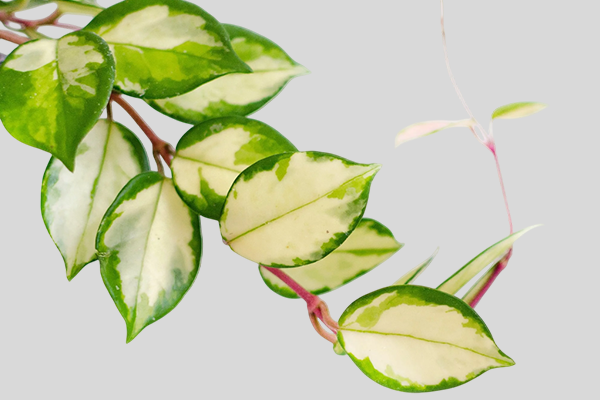
Hoya
Hoya is a popular houseplant native to the tropical forests of Southeast Asia and Australia. It is a vining plant with thick, waxy (partly succulent) leaves and fragrant star-shaped flowers, which is why it’s often called “wax ivy.” In homes, decorative hybrid cultivars — many with variegated foliage — are common. Well adapted to indoor life, Hoya can bloom for years when trained as a hanging plant or on a trellis.
Placement
Provide bright, indirect light. East- or west-facing windows are ideal. On south-facing windows, give light midday shading to prevent leaf scorch. In deep shade, growth continues but flowering becomes sparse. Avoid moving the pot frequently — especially while buds are forming, keep the plant in one place.
Watering
Water moderately. In spring and summer, water about 1–2 times per week once the top layer of soil dries slightly. In autumn and winter, reduce frequency and allow the soil to dry 2–3 cm deep. Overwatering is risky: roots rot easily. It’s safer to underwater than overwater. Use soft, settled water. Wipe leaves with a damp cloth to remove dust; misting is generally unnecessary — Hoya copes well with dry air.
Fertilizing
Feed during active growth and bloom (spring–summer) every 2–3 weeks with a complete fertilizer for flowering plants; higher potassium and phosphorus are beneficial. Stop feeding in autumn–winter. Excess nitrogen promotes foliage at the expense of flowers.
Repotting
Hoya dislikes frequent repotting. Repot young plants every 2–3 years; mature plants only when necessary (spring is best). Choose a relatively snug pot — slight root restriction encourages flowering. Use a light, airy, well-drained mix, pH 5.5–6.5: leaf mold, peat, humus, and sand. A blend of universal potting mix with orchid substrate also works well.
Temperature
Optimal temperatures are +20…+25 °C during growth and bloom. In winter, slightly cooler conditions (+15…+18 °C) help set flower buds. Do not expose Hoya to temperatures below +10 °C. It is not frost-tolerant; even brief frost is fatal.
Pruning
Frequent pruning isn’t required — remove only dry or damaged parts (preferably in spring). Important: flowers develop on old spurs and peduncles, so do not cut them after blooming; leaving them encourages reblooming next season. Light pinching of young shoots improves branching; guide new vines onto supports.
Conclusion
Hoya is one of the most rewarding houseplants, combining attractive foliage with abundant, fragrant blooms. Give it bright, indirect light, moderate watering, seasonal feeding, repot only when needed, keep suitable temperatures, and handle old flower spurs carefully — and it will adorn your home for many years.
